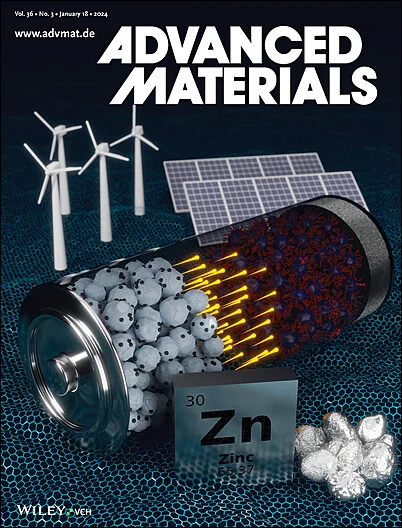Stable n‐Type Conducting Elastomer with High Stretchability and Electrical Conductivity
IF 26.8
1区 材料科学
Q1 CHEMISTRY, MULTIDISCIPLINARY
引用次数: 0
Abstract
Stretchable n‐type conducting polymers are crucial for advancing high‐performance optoelectronic and bioelectronic devices, yet their development lags significantly behind that of p‐type counterparts due to the intrinsic challenge of harmonizing electrical conductivity with mechanical compliance. Herein, a novel strategy is reported to engineer a high‐performance n‐type conductive elastomer by synergistically blending the n‐type polymer poly(benzodifurandione) (PBFDO) with thermoplastic polyurethane (TPU) and modulating phase separation via the ionic liquid (IL) 1‐butyl‐3‐methylimidazolium tetrafluoroborate. The resulting PBFDO/TPU/IL composites (PBTI) achieve an unprecedented combination of n‐type electrical conductivity exceeding 200 S cm稳定的n型导电弹性体,具有高拉伸性和导电性
可拉伸的n型导电聚合物对于推进高性能光电和生物电子器件至关重要,但由于协调导电性和机械顺应性的内在挑战,它们的发展明显落后于p型聚合物。本文报道了一种新型策略,通过将n型聚合物聚(苯并二呋喃二酮)(pbdo)与热塑性聚氨酯(TPU)协同共混,并通过离子液体(IL) 1 -丁基- 3 -甲基咪唑四氟硼酸盐调节相分离,来设计高性能n型导电弹性体。由此产生的pbdo /TPU/IL复合材料(PBTI)实现了前所未有的n型电导率超过200 S cm−¹,断裂伸长率超过200%,以及强大的运行稳定性,优于现有的可拉伸n型导电聚合物。受控的相分离形态确保了有效的电荷传输,同时保持弹性弹性,解决了长期存在的导电性和拉伸性之间的权衡。PBTI与p型PEDOT:PSS弹性体集成,以证明其在构建可拉伸热电发电机(TEG)中的多功能性,该发电机在机械变形下表现出可靠的功率输出。在火灾安全预警和实时人体生理监测方面的进一步应用强调了该材料在自适应可穿戴和植入式系统中的实用性。这项工作在n型可拉伸导体领域开辟了新天地,为需要平衡电子和机械功能的复杂生物电子学和自供电设备铺平了道路。
本文章由计算机程序翻译,如有差异,请以英文原文为准。
求助全文
约1分钟内获得全文
求助全文
来源期刊

Advanced Materials
工程技术-材料科学:综合
CiteScore
43.00
自引率
4.10%
发文量
2182
审稿时长
2 months
期刊介绍:
Advanced Materials, one of the world's most prestigious journals and the foundation of the Advanced portfolio, is the home of choice for best-in-class materials science for more than 30 years. Following this fast-growing and interdisciplinary field, we are considering and publishing the most important discoveries on any and all materials from materials scientists, chemists, physicists, engineers as well as health and life scientists and bringing you the latest results and trends in modern materials-related research every week.
 求助内容:
求助内容: 应助结果提醒方式:
应助结果提醒方式:


